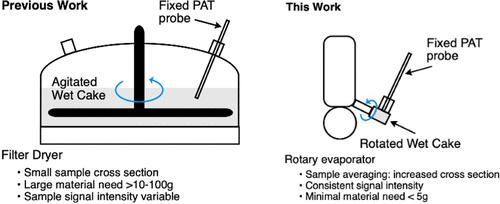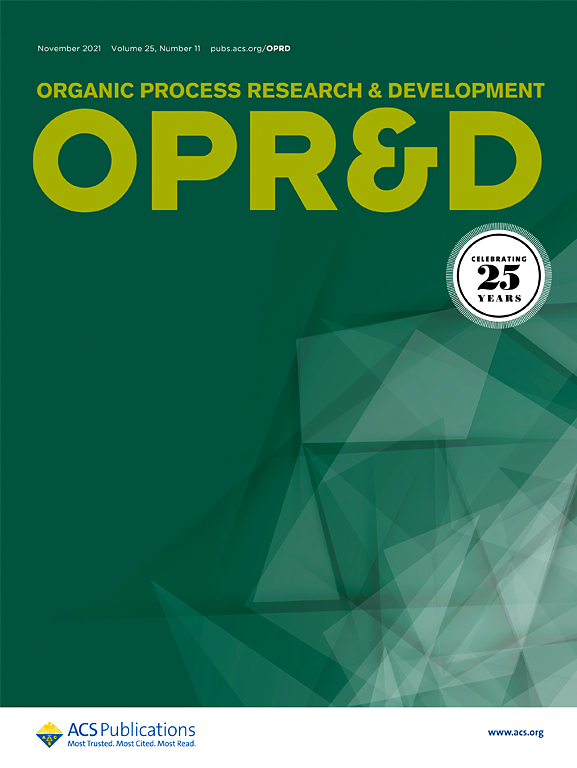Improved Process Understanding of Filtration Drying via a Rotary Evaporator-Based Process Analytical Technology (PAT) Interface
IF 3.5
3区 化学
Q2 CHEMISTRY, APPLIED
引用次数: 0
Abstract
The filtration drying of chemical solids is a critical unit operation in the isolation of active pharmaceutical ingredients and intermediates during the manufacturing process. Due to its central role in API isolation, it is important to understand the kinetics of filtration and drying processes to ensure minimal timeline impact and, importantly, the quality of the API produced. Process analytical technologies (PAT), such as Raman spectroscopy, near-infrared spectroscopy (NIRS), gas chromatography (GC), and mass spectrometry (MS), have been used to monitor filtration drying operations to provide real-time solvent content concentrations. However, each instrument has limitations, such as the need for at-scale calibration experiments with Raman and NIRS, and for GC and MS, the difficulty of correlating the headspace solvent concentration to the wet cake. Furthermore, current PAT methods to assess drying kinetics have large material demands, in even the smallest scale-down filter dryers, and lack representative measurements in a heterogeneous gas–solid sample matrix. To address some of these challenges, a drying workflow using a rotary evaporator (rotavap) with PAT interfaces has been developed in our lab. This unique rotavap PAT interface improves upon existing PAT drying methods because it reduces the material demand to as little as 1 g and, due to the rotational mechanism of the rotavap, ensures representative sampling by PAT of the wet cake during the drying curve collection. Three different drying case studies were carried out using the rotavap PAT interface and are illustrated herein. Initial slurry and final solid residual solvent concentrations were measured by GC or Karl Fischer (KF) methods and served not only as reference measurements for calibrating PAT sensors but were also used to rescale predicted solvent content by vibrational spectroscopy to capture accurate drying dynamics. Such PLS models were then applied to different experimental conditions across all three case studies, such as various drying temperatures and nitrogen sweep rates, to inform process understanding of the normal operating range of the filtration drying step. The alignment between the model predictions and offline reference measurements successfully demonstrates the value of the rotava p-based PAT interface for collecting filtration drying data in a material-sparing manner. This approach is expected to streamline the process development of API filtration drying steps by helping to determine the drying end point and also providing real-time drying data for kinetic modeling that could be used to predict drying outcomes at variable scales and across different filtration dryer designs.

通过基于旋转蒸发器的过程分析技术(PAT)接口改进对过滤干燥过程的理解
化学固体的过滤干燥是生产过程中分离活性药物成分和中间体的关键单元操作。由于其在原料药分离中的核心作用,了解过滤和干燥过程的动力学非常重要,以确保最小的时间影响,更重要的是,生产的原料药的质量。过程分析技术(PAT),如拉曼光谱(Raman spectroscopy)、近红外光谱(NIRS)、气相色谱(GC)和质谱(MS),已被用于监测过滤干燥操作,以提供实时溶剂含量浓度。然而,每种仪器都有局限性,例如需要用拉曼和近红外光谱进行大规模校准实验,并且对于气相色谱和质谱来说,很难将顶空溶剂浓度与湿饼相关联。此外,目前用于评估干燥动力学的PAT方法对材料的需求很大,即使是最小的按比例缩小的过滤器干燥器,也缺乏对非均相气固样品基质的代表性测量。为了解决这些挑战,我们的实验室开发了一种使用带有PAT接口的旋转蒸发器(rotavap)的干燥工作流程。这种独特的rotavap PAT接口改进了现有的PAT干燥方法,因为它将物料需求减少到1g,并且由于rotavap的旋转机制,确保在干燥曲线收集过程中对湿饼进行具有代表性的PAT取样。使用rotavap PAT接口进行了三种不同的干燥案例研究,并在此进行了说明。初始浆液和最终固体残余溶剂浓度通过气相色谱或卡尔菲舍尔(KF)方法测量,不仅作为校准PAT传感器的参考测量值,而且还用于通过振动光谱法重新调整预测的溶剂含量,以捕获准确的干燥动态。然后将这些PLS模型应用于所有三个案例研究中的不同实验条件,例如不同的干燥温度和氮气扫速,以告知流程对过滤干燥步骤的正常操作范围的理解。模型预测和离线参考测量之间的一致性成功地证明了基于旋转塔p的PAT接口在以节省材料的方式收集过滤干燥数据方面的价值。这种方法有望通过帮助确定干燥终点,并为动力学建模提供实时干燥数据,从而简化原料药过滤干燥步骤的流程开发,可用于预测不同规模和不同过滤干燥器设计的干燥结果。
本文章由计算机程序翻译,如有差异,请以英文原文为准。
求助全文
约1分钟内获得全文
求助全文
来源期刊
CiteScore
6.90
自引率
14.70%
发文量
251
审稿时长
2 months
期刊介绍:
The journal Organic Process Research & Development serves as a communication tool between industrial chemists and chemists working in universities and research institutes. As such, it reports original work from the broad field of industrial process chemistry but also presents academic results that are relevant, or potentially relevant, to industrial applications. Process chemistry is the science that enables the safe, environmentally benign and ultimately economical manufacturing of organic compounds that are required in larger amounts to help address the needs of society. Consequently, the Journal encompasses every aspect of organic chemistry, including all aspects of catalysis, synthetic methodology development and synthetic strategy exploration, but also includes aspects from analytical and solid-state chemistry and chemical engineering, such as work-up tools,process safety, or flow-chemistry. The goal of development and optimization of chemical reactions and processes is their transfer to a larger scale; original work describing such studies and the actual implementation on scale is highly relevant to the journal. However, studies on new developments from either industry, research institutes or academia that have not yet been demonstrated on scale, but where an industrial utility can be expected and where the study has addressed important prerequisites for a scale-up and has given confidence into the reliability and practicality of the chemistry, also serve the mission of OPR&D as a communication tool between the different contributors to the field.

 求助内容:
求助内容: 应助结果提醒方式:
应助结果提醒方式:


